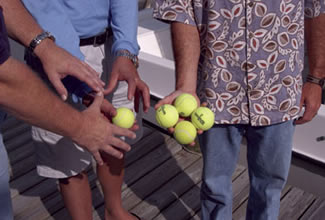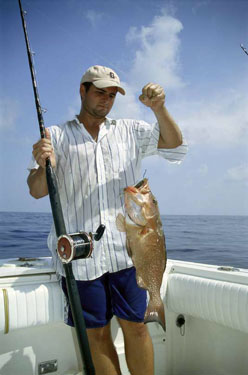May 16, 2011
By David Brown
Anglers Urged to Protest on All Levels

As shown on a "Just a Conservation Minute" feature on Florida Sportsman TV, four out of five balls representing all red grouper catches are taken by industrial commercial interests, even though recreational anglers are in the vast majortiy and generate more economic benefits, including jobs.
|
Florida anglers are fit to be tied, as the saying goes, over a sudden federal proposal to cut the red grouper bag limit from two to one and close down all recreational fishing for the popular species for up to four months.
The cutback would be a crushing blow to grouper fishing, especially off the west coast, where the reds are a mainstay for many thousands of anglers.
Sportfishing groups and individuals are protesting against the proposal to officials on all levels and calling for the general public to mount major opposition.
The National Marine Fisheries Service (NMFS) announced the suggested cutbacks on non-commercial red grouper takes on the basis of a highly suspect research claim that recreationals caught nearly 2.4 times more red grouper last year than in 2003.
A series of hearings and meetings are under way (see www.floridasportsman.com).
The new estimated catch based on federal dock samplings and phone surveys has drawn fire from many because no such increase has been reported before, and because no similar increase occurred in data from charter and head boats.
Normally, such a spike in the data would cause no immediate reaction, but because red grouper is an “overfished” species and subject to a 10-year rebuilding plan (starting in 2003), the feds are scrambling to get the recreational portion of the total allowable catch back “in line.” Under the 10-year plan, commercial and recreational landings must not exceed a set number in the first three years. Thus, the Gulf of Mexico Fishery Management Council's objective is to knock down recreational landings in 2005 and level out a 3-year average.
That would be reasonable if the numbers were believable, but as Ted Forsgren of Coastal Conservation Association Florida (CCA) said, “The problem with the [2004 increase] is that nothing even remotely close to that has ever happened in the 16-year history of managing red grouper.”
Moreover, the Council's data shows that private individuals—not licensed charterboats or headboats—supposedly accounted for the greatest increases in 2004 recreational catches.
“If I believed the numbers, and if everyone else believed the numbers, I'd be the first one to say we have to do something—we really need to look at this,” said Dennis O'Hern, president of the Fishing Rights Alliance (FRA), a recreational fishing and conservation advocacy group. “However, I believe and a lot of people believe that those numbers are artificially high.”
Also, consider last year's weather woes. Rather than spending more time catching more fish, Florida anglers were too busy entertaining a quartet of rude visitors named Charlie, Frances, Ivan and Jeanne. But if we are to understand the feds correctly, we intrepid Floridians managed to more than double our red grouper catches during a year that saw the state's most destructive hurricane season in recent history.
Now you can't drain the ocean and count fish, nor are you likely to identify every single red grouper catch in a given year. Therefore “estimated” data is always an assumption that we just have to live with. But in the case at hand, it seems we could replace “estimated” with “wild guess” and remain in the same ballpark.
It's not that the computational methods used by NMFS are necessarily wrong—it's just that the data is sketchy and suspect.
Meantime, plans are shelved to move Gulf longlines out to 300-foot depths. |
|
The numbers come from dockside intercept surveys, which estimate catch amounts, and household telephone surveys aimed at estimating fishing effort. With the former, the feds hire private contractors to visit recreational boats, weigh fish and gather catch details. Phone surveys, done via random dialing, typically garner low responses, so surveyors simply hammer away on the phones until they get enough confirmed fishing trips to satisfy their minimum data set.
Bob Bryant of St. Petersburg is a charter captain and an actuarial analyst for the life insurance industry. His number crunching experience tells him something is greatly amiss.
“The models are not flawed, but it's like the old computer adage ‘garbage in, garbage out,'” he said. “You can have the best models in the world, but if your data is tainted, the results will be incorrect.
“Whenever performing experiments on data, all statisticians are trained to question results that reside far outside the norm. I, for one, would not have certified these results and would have sent them back to the data collectors for further review. Management decisions are to be based on ‘best available science' as stated in the Magnuson/Stevens Act. This set of data is not the ‘best available science'.”

This one red grouper would represent this man's bag limit, if the new regs pass.
|
When the Council announced its proposed plan in March, the CCA and FRA requested public hearings before any action would be taken. The Council agreed to hear public comment at a series of meetings and has indicated it will announce a decision in July.
If the bag limit reduction and seasonal closure are enacted, Florida can expect an enormous economic impact as many recreational boats—which vastly outnumber commercial boats—stay at port and forego their usual expenditures on fuel, oil, bait, ice, food, beverages and equipment.
That might be a bitter pill more easily swallowed if the Council prescribed equal medicine for the commercial industry. But the Council's history of bowing to commercial lobbying offers little hope for equitable decisions.
Forsgren notes, “There's more red grouper being allocated to a small handful of longlining boats than to the entire recre
ational fishery. We think that's totally out of whack. Our question is that how in the world can you [close the recreational season] when you're allowing commercial longliners to take 10,000 pounds of red grouper per trip. That makes no sense.”
Three years ago, the Gulf Council was actually poised to prohibit commercial longline fishing in waters shallower than 300 feet. It was a proposal supported by CCA, the Florida Fish and Wildlife Conservation Commission and other conservationists. As damaging to reef habitat as it is to fish stocks, the multi-hook, passive longline gear was long ago outlawed in Florida state waters, South Atlantic federal waters, and some parts of the Gulf of Mexico. On the Gulf red grouper grounds, however, longline fishing grew unchecked until, by the late 1980s, it accounted for the lion's share of the regional grouper haul—eclipsing recreational catches. As evidence of a red grouper stock decline in the Gulf emerged in the late 1990s, authorities finally began taking an honest look at removing longline gear from the red grouper grounds. After some backroom meanderings, the Council reversed course in 2003 when NMFS mysteriously produced a rosier stock assessment for red grouper. Instead of curtailing longline fishing, the Council trimmed the commercial quota and cut the recreational bag limit from 5 red grouper per person, to 2.
Fast forward to 2005: For the feds to further trim already meager recreational limits, based on highly suspect data, is unacceptable, if not downright insulting.
Hopefully, a seabreeze of sensibility will dispel the haze of statistical misrepresentation behind the latest NMFS plan. Otherwise, it would be a tragic day when the local fish market is the only spot recreational anglers will be allowed to visit for red grouper.
Next month: While anglers accept single-fish limits and closures, fisheries managers typically dole out excessive amounts to commercial interests.
FS

